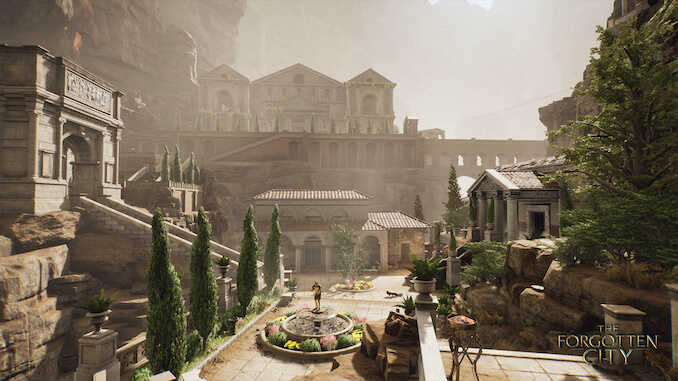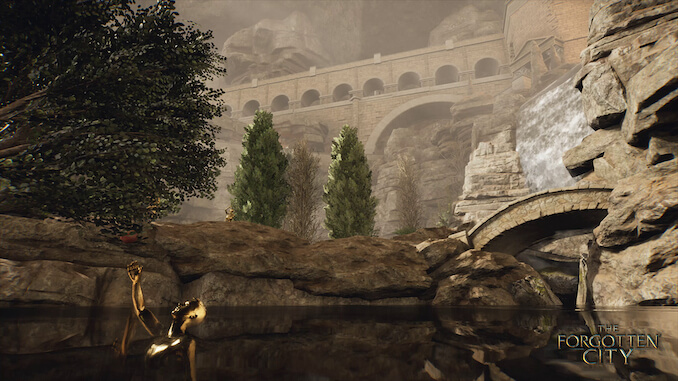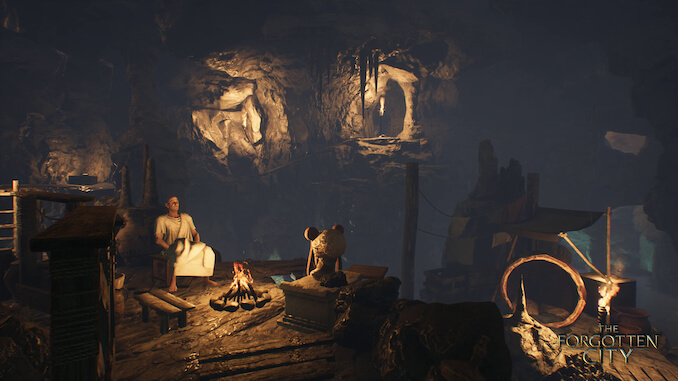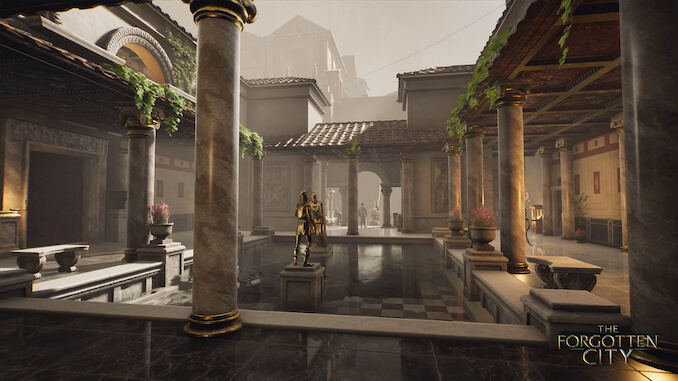Our review of The Forgotten City, developed by Modern Storyteller. Available now for PS5 (reviewed), PS4, Xbox One, Xbox Series S/X, and Windows.

WHAT IS IT?
A time loop mystery.
IS IT GOOD?
It’s a great, tightly woven and altogether satisfying mystery.
WHO SHOULD PLAY IT?
Amateur sleuths.

WHAT’S PAST IS PROLOGUE
The Forgotten City is a bit of an odd duck: it looks like a first-person RPG, it’s scripted like a detective game, but its central time loop mechanic almost makes it a puzzler. City is all about learning patterns, remembering key details gleaned from your previous visit, before you “reset” and start the next time loop from the beginning. Maybe there’s a character who is deathly ill. First “loop”, you talk to various townspeople, eventually figure out what’s needed for the cure. But it’s too late: they’ve died. Next loop, you skip the conversations and go straight to where you you hope to find the cure – but the person who holds it isn’t amenable to sharing. Once again, you’ve taken too long: the ill character dies. But in The Forgotten City, all that is just the beginning: resetting repeatedly, you eventually figure out the correct (and quickest) path, obtaining the cure, delivering it just in the nick of time. A character who you saw die two, three, perhaps a dozen times has now, finally, survived. Not only that, but another character, who you met five or six loops ago, would be very interested in that information.
The Forgotten City is the Groundhog Day of video games: reliving the same day over and over, the only way to escape is to learn the intricacies of its world and of what is expected to happen, using that information to your advantage. It also offers multiple paths “out”: some destructive, some that save yourself but not others, and some that resolve the greatest of its mysteries. It’s up to you which paths you choose, but its multiple endings make The Forgotten City worth revisiting again and again.

DEJA VU ALL OVER AGAIN
The Forgotten City began life as a mod of first-person RPG The Elder Scrolls: Skyrim. The original Forgotten City, released for free in 2015, was the work of one man, Nick Pearce, a hobbyist game designer who took the Skyrim source code and used it to craft a discrete time loop murder mystery. Pearce went on to win an Australian Writer’s Guild Award for his work, setting him on the path towards adapting it into a fully-fledged standalone experience (one stripped, for obvious intellectual property reasons, of its Skyrim trappings).
Set in an ancient Roman city, players must unravel a combination of the big, overarching mysteries – how it is you’ve arrived there from the present day, how to escape – along with the many intricately plotted storylines presented by the twenty or so other inhabitants in the unnamed city. What happened to the magistrate’s daughter, who has been missing for weeks? Who’s been harrassing the shopkeeper Vergil? What to do about the despondent Ulpius, when every person he cares for is either missing or dead?
Superimposed on all of this are two more major plot threads. Firstly, you’ve arrived on the day of the magisterial election, and there may be good reasons to support one candidate over another on any given “loop.” Secondly, the titular city is governed by a magical curse: if anyone breaks any of its fundamental laws – do not kill and do not steal are the obvious ones, though others are more oblique – then everyone is immediately sentenced to die. Indeed, you’ll wind up spending much of the game fleeing impending death, racing to reset the loop because someone has done something to set off the curse. Without spoiling its exact nature, I can tell you that every time the curse is activated, it’s suitably terrifying.

CAUSE AND EFFECT
The Forgotten City is a very “neat” package. Its myriad threads tie together in ways that make sense. It has very little in the way of annoying red herrings. Most importantly, its mysteries, big and small, are all resolved in satisfying ways. Provided you take the time to explore its different endings – something which the game encourages, since each “reset” allows you to carry over all knowledge and items obtained in previous loops – you’re likely to come away with all your questions answered. Incidentally, I also love how, in order to save time, the game implements a shortcut mechanic: every time you start a new loop, there’s a character standing by, eager to run errands for you based on what you’ve learned from previous loops. (To wit: you’ll only need to hand-deliver that medicine once; every subsequent visit, you can instruct your errand boy to dash off and take care of that whole subplot on his own.)
I can count on one hand the number of truly great detective games that have been made. Rockstar’s L.A. Noire, which in 2011 trained players to read the facial expressions of digital suspects, is probably the prime example, though I’m particularly partial to Return of the Obra Dinn and its unique “frozen-time” crime scene analysis. (Come to think of it, there are shades of Obra Dinn to be found in Forgotten City, both first-person mysteries playing with concepts of time, encouraging players to revisit the same moments over and over in order to unravel their central mysteries.)
Groundhog Day is another obvious reference, but so too is the classic Star Trek: The Next Generation episode “Cause and Effect“, which in fact predates Groundhog Day by a couple years. In that classic Season 5 TNG episode, the crew is caught in a time loop, and it’s up to Captain Patrick Stewart and the rest to figure out how to avoid their pending, repeated, destruction. TNG was notable amongst sci-fi properties for eschewing violence in favour of dialogue, for exploring peaceful solutions instead of leaping into combat. “Cause and Effect” is one of Star Trek‘s finest hours, in large part an episode about investigation, about keeping a watchful eye out for clues as the loop repeats itself.
The Forgotten City, the video game equivalent, is easily up there among the best of the detective genre. Though it definitely has its weaknesses – animation is stilted, some of the storylines resolve too easily – it’s still a finely plotted mystery that’s quite unlike anything else on the market. And like “Cause and Effect” before it, it mostly avoids combat, though what’s there is enjoyable and sometimes even frightening. Latin-speaking groundhogs would approve.
***
Final score: 9/10 time loops.
Visit the official page for The Forgotten City here.



